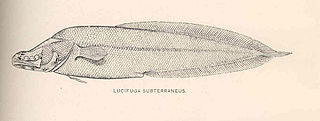
Lucifuga is a genus of viviparous brotulas. Most of the species are native to caves and sinkholes in Cuba and the Bahamas; L. inopinata from deep water off the Galápagos Islands is the only exception. The four species rated by the IUCN are all considered vulnerable. The largest species in the genus reaches about 15 cm (5.9 in) in length.

Ogilbia is a genus of viviparous brotulas. The generic name honours the Australian naturalist James Douglas Ogilby (1853-1925), for his contribution to the knowledge of the fishes of Australia.

Saccogaster is a genus of viviparous brotulas. They are found in the western Atlantic and Indo-Pacific.
Dermatopsis is a genus of viviparous brotulas.
Dermatopsoides is a genus of viviparous brotulas.
Diancistrus is a genus of viviparous brotulas.
Didymothallus is a genus of viviparous brotulas found in the Indian and western Pacific Oceans.
Eusurculus is a species of viviparous brotula.
Gunterichthys is a genus of viviparous brotula.
Majungaichthys is a genus of viviparous brotulas native to the western Indian Ocean. The generic name refers to Majunga in Madagascar where the type was collected.
Mascarenichthys is a genus of viviparous brotulas. They have mostly been collected from the region of Mascarene Plateau in the Indian Ocean and this is referred to in their generic name.
Microbrotula is a genus of viviparous brotulas.
Ogilbichthys is a genus of viviparous brotulas found in the central-western Atlantic Ocean and the Caribbean Sea. he generic name refers to the resemblance of these fish to those in the genus Ogilbia, a name honours the Australian naturalist James Douglas Ogilby (1853-1925), combined with ichthys which means "fish" in Greek.
Paradiancistrus is a genus of viviparous brotulas.
Timorichthys is a genus of viviparous brotulas so far known from the East China Sea and the Timor Sea.
Ungusurculus is a genus of viviparous brotulas found in the western Pacific Ocean.

Sirembo is a genus of cusk-eels of the subfamily Neobythitinae, family Ophidiidae, which are found in the Indian and Pacific Oceans. The species in this genus have a rather robust body with the dorsal fin originating over vertebrae 1–5. The head and bod are completely covered in scales, they have large eyes which are almost equal in diameter to the length of snout, the pelvic fins have two rays which are joined together within an area of tough skin, They have a short spine on the operculum which does not extend to the posterior edge of the head. Their coloration is variable but almost all species have black spots or eyespots on the dorsal fin, sometimes both, while the middle part of the anal fin frequently has a black band. The body and/or head are marked with diagonal or horizontal dark stripes or horizontal rows of quite large dusky spots.
Spottobrotula is a genus of cusk-eels.

Bythitinae is a subfamily of viviparous brotulas, one of the two subfamilies in the family Bythitidae. This subfamily is characterised by having the dorsal, caudal and anal fins combined. They are mostly found in temperate to tropical seas, from reefs to the benthopelagic zone, but some species from the North Atlantic Ocean occur in into Arctic waters.





